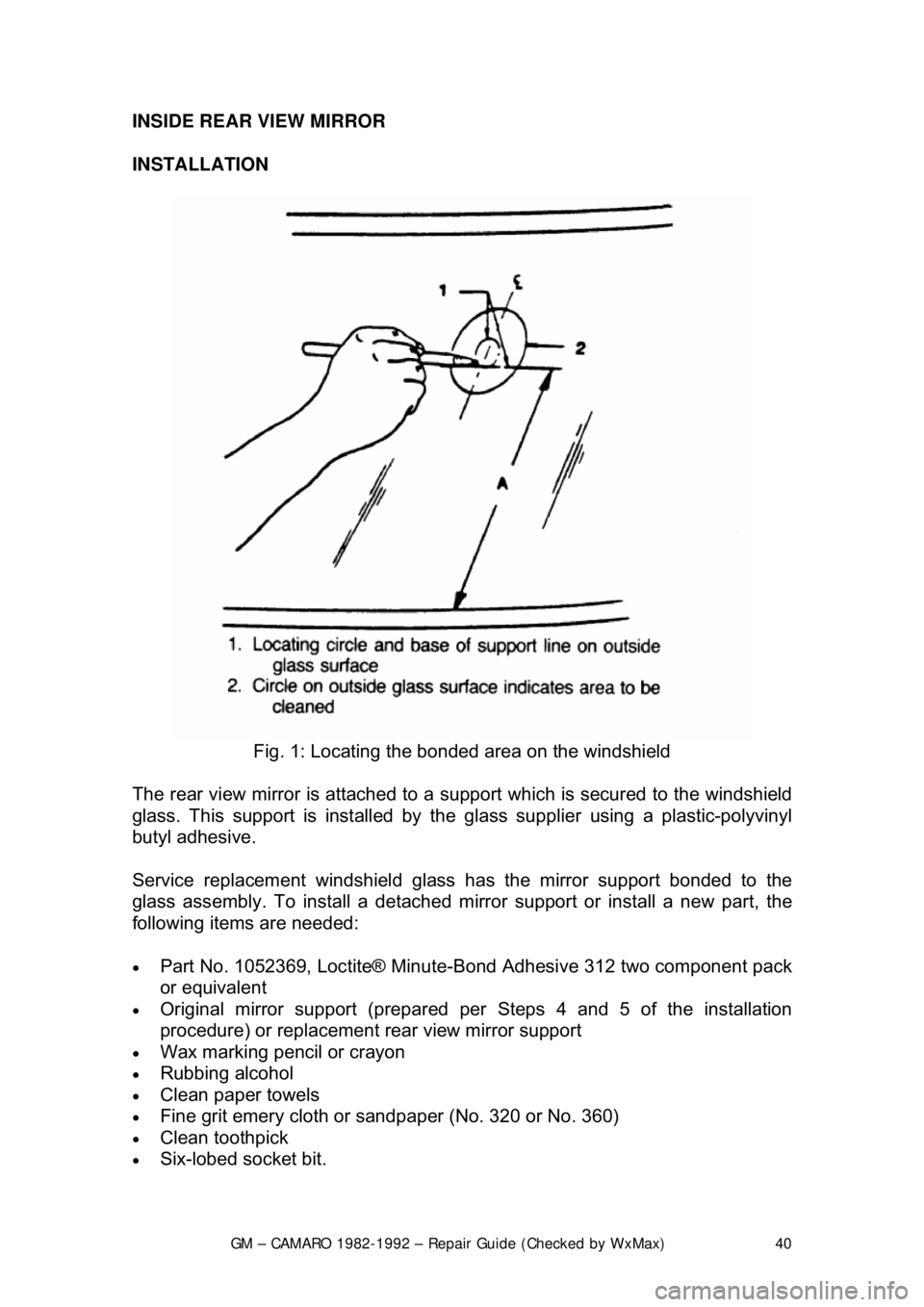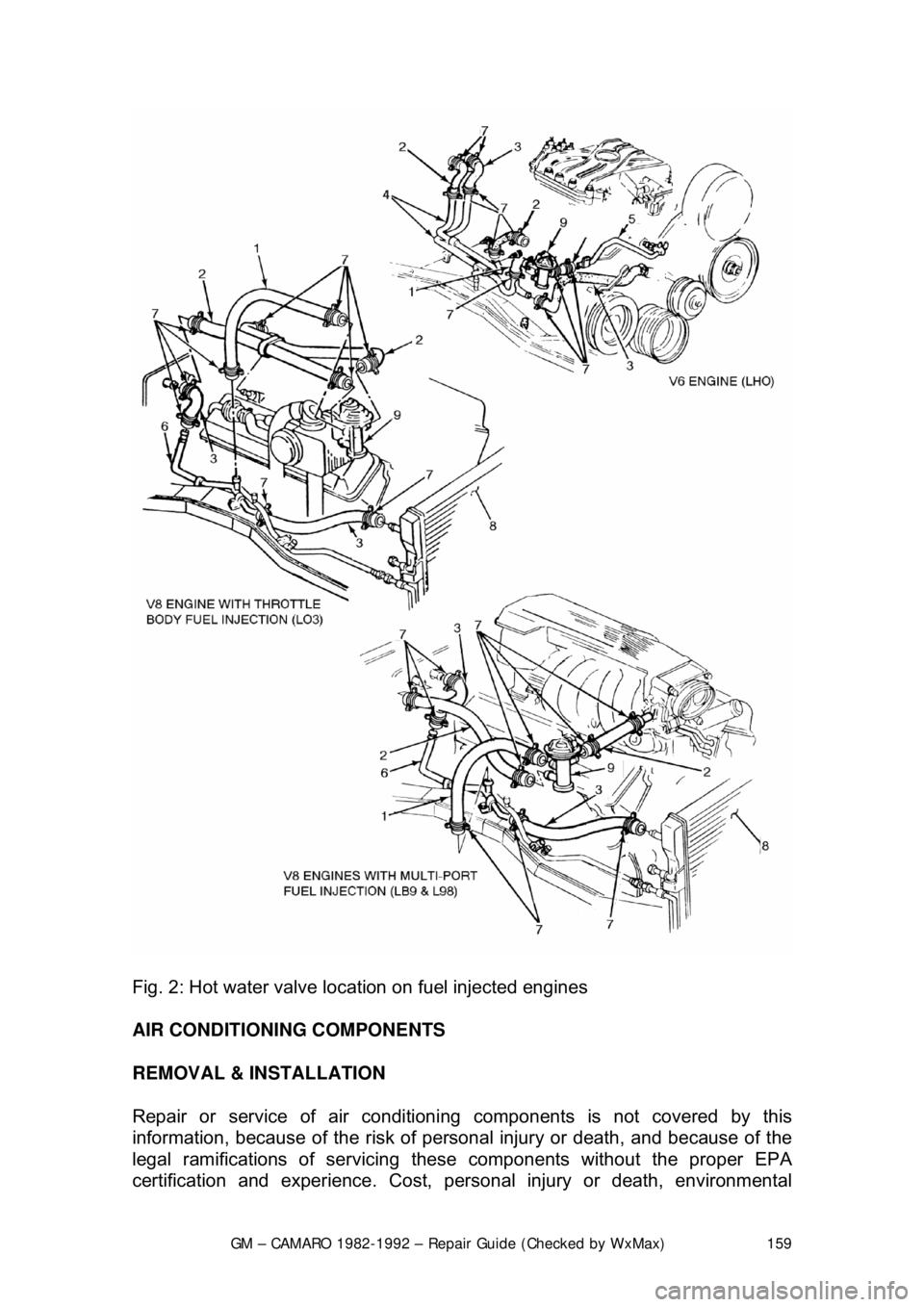1982 CHEVROLET CAMARO service
[x] Cancel search: servicePage 4 of 875

GM – CAMARO 1982-1992 – Repair Guide (Checked by WxMax) 4
1. On doors that are equipped with
power operated components, do the
following:
• Remove the door trim panel an d inner panel water deflector.
• Disconnect the wire harness from all components in the door.
• Remove the rubber conduit from t he door, then remove the wire harness
from the door through t he conduit access hole.
2. Tape the area (on the door pillar and b ody pillar) above the lower hinge with
cloth backed body tape.
CAUTION - Before performing the following step, cover the spring with a shop
cloth or rag to prevent the spring fr om flying and possibly causing personal
injury or damage.
3. Insert a long, flat-blade screwdriver under the pivot point of the hold-open
link and over the top of the spring. T he screwdriver should be positioned so
as not to apply pressure to the hol d-open link. Cover the spring with a shop
cloth or rag and lift the screwdriver to disengage the spring. The spring can
also be removed by using tool J- 36604 (or equivalent) door hinge spring
compressor tool.
The tool is stamped right side and left side. The tool stamped left side is used to
service the right-hand hinge spring and vi se-a-versa for the tool stamped right
side.
4. With the aid of a helper to suppor t the door, remove the lower hinge pin
using a soft-headed hammer and locking type pliers. The helper can aid the
hinge pin removal by raising and lowering the rear of the door.
5. Insert a bolt into the hole of the lo wer hinge to maintain the door attachment
during upper hinge removal.
6. Using a 13mm socket, remove the upper hinge bolts from the pillar. Remove
the bolt from the lower hinge and re move the door from the body.
To install:
7. Replace the hinge pin clip.
8. With the aid of a helper, position t he door and insert the bolt in the hole of
the lower hinge.
9. Bolt the upper hinge to the body. The lower hinge pin is installed with the
pointed end down.
10. Remove the screw from the lower hi nge and install the lower hinge pin. The
use of tool J-36604 or equi valent is recommended for installing the hinge
spring.
If the spring is installed before inst alling the lower hinge pin, damage to the
hinge bushings may result.
11. If the spring was removed using a screw driver, install the spring as follows:
Page 37 of 875

GM – CAMARO 1982-1992 – Repair Guide (Checked by WxMax) 37
WINDSHIELD AND FIXED GLASS
REMOVAL & INSTALLATION
If your windshield, or other fixed window,
is cracked or chipped, you may decide
to replace it with a new one yourself. Ho wever, there are two main reasons why
replacement windshields and other windo w glass should be installed only by a
professional automotive glass technician: safety and cost.
The most important reason a professional should install automotive glass is for
safety. The glass in the vehicle, espec ially the windshield, is designed with
safety in mind in case of a collision. The windshield is specially manufactured
from two panes of specia lly-tempered glass with a th in layer of transparent
plastic between them. This construction allows the glass to "give" in the event
that a part of your body hits the windshiel d during the collision, and prevents the
glass from shattering, which could caus e lacerations, blinding and other harm to
passengers of the vehicle. The other fixed windows are designed to be
tempered so that if they break during a coll ision, they shatter in such a way that
there are no large pointed glass piec es. The professional automotive glass
technician knows how to install the glass in a vehicle so that it will function
optimally during a collision. Without the proper experience, knowledge and
tools, installing a piece of automotive glass yourself could lead to additional
harm if an accident should ever occur.
Cost is also a factor when deciding to install automotive glass yourself.
Performing this could cost you much more than a professional may charge \
for
the same job. Since the windshield is designed to break under stress, an often
life saving characteristic, windshields tend to break VERY easily when an
inexperienced person attempts to install one. Do-it-yourselfers buying two, three
or even four windshields from a salvage yard because they have broken them
during installation are common stories. Also, since the automotive glass is
designed to prevent the out side elements from entering your vehicle, improper
installation can lead to water and air lea ks. Annoying whining noises at highway
speeds from air leaks or inside body pane l rusting from water leaks can add to
your stress level and subtract from y our wallet. After buying two or three
windshields, installing them and ending up with a leak that produces a noise
while driving and water damage during ra instorms, the cost of having a
professional do it correctly the first time may be much more alluring. The editors
of this repair guide, therefore, advise that you have a professional automotive
glass technician service any broken glass on your vehicle.
WINDSHIELD CHIP REPAIR
Check with your state and local authori ties on the laws for state safety
inspection. Some states or municipalities may not allow chip repair as a viable
option for correcting stone damage to your windshield.
Although severely cracked or damaged winds hields must be replaced, there is
something that you can do to prolong or even prevent the need for replacement
of a chipped windshield. T here are many companies wh ich offer windshield chip
Page 40 of 875

GM – CAMARO 1982-1992 – Repair Guide (Checked by WxMax) 40
INSIDE REAR VIEW MIRROR
INSTALLATION
Fig. 1: Locating the bonded area on the windshield
The rear view mirror is attached to a s upport which is secured to the windshield
glass. This support is inst alled by the glass supplier using a plastic-polyvinyl
butyl adhesive.
Service replacement windshield glass has the mirror support bonded to the
glass assembly. To install a detached mi rror support or install a new part, the
following items are needed:
• Part No. 1052369, Loctite® Minute-B ond Adhesive 312 two component pack
or equivalent
• Original mirror support (prepared per Steps 4 and 5 of the installation
procedure) or replacement rear view mirror support
• Wax marking pencil or crayon
• Rubbing alcohol
• Clean paper towels
• Fine grit emery cloth or sandpap er (No. 320 or No. 360)
• Clean toothpick
• Six-lobed socket bit.
Page 64 of 875

GM – CAMARO 1982-1992 – Repair Guide (Checked by WxMax) 64
This is a tedious, time-consuming job. You
can save yourself a lot of trouble by
buying a rebuilt master cylinder from y our dealer or parts supply house. The
small difference in price between a r ebuilding kit and a rebuilt part usually
makes it more economical, in terms of time and work, to buy the rebuilt part.
1. Remove the reservoir cover and diap hragm. Discard any brake fluid in the
reservoir.
2. Inspect the reservoir cover and diaphr agm for cuts, cracks, or deformation.
Replace any defective parts.
3. Depress the primary pist on and remove the lock ring.
4. Direct compressed air into the outle t at the blind end of the bore and plug
the other outlet to remove primary and secondary piston.
5. Remove the spring retainer and s eals from the secondary piston.
6. Clamp the master cylinder in a vise. Do not clamp it on the master cylinder
body. Use a pry bar to re move the reservoir.
7. Do not attempt to remove the quick take-up valve from the body. This valve
is not serviced separately.
8. Remove the reservoir grommets.
9. Inspect the master cylinder bore for corrosion. If corroded, replace the
master cylinder. Do not use any abrasive on the bore.
10. Reassemble, using new seals and gr ommets. Lubricate all parts with brake
fluid.
11. Install the reservoir grommets.
12. Install the reservoir.
13. Install the spring retainer and seals from the secondary piston.
14. Install primary and secondary piston.
15. Depress the primary pist on and install the lock ring.
16. Fill with brake fluid. Install the reservoir cover and diaphragm.
17. Bleed brake system.
Page 66 of 875

GM – CAMARO 1982-1992 – Repair Guide (Checked by WxMax) 66
4. Remove nuts and lockwashers that se
cure booster to firewall and remove
booster from engine compartment.
5. Install by reversing removal procedure. Make sure to check operation of stop
lights. Allow engine vacuum to build before applying brakes.
COMBINATION VALVE
REMOVAL & INSTALLATION
This valve is not repairable and only serviced as a complete assembly.
1. Disconnect the hydraulic lines from t he valve. Plug the lines to prevent fluid
loss and dirt contamination.
2. Disconnect the electrical connection.
3. Remove the valve.
To install:
4. Position the valve.
5. Connect the electrical connection.
6. Connect the hydraulic lines to the valve.
7. Bleed the brake system.
Page 134 of 875

GM – CAMARO 1982-1992 – Repair Guide (Checked by WxMax) 134
CONNECTORS
Three types of connectors
are commonly used in automotive applications -
weatherproof, molded and hard shell.
Fig. 4: Hard shell (left) and weather proof (right) connectors have replaceable
terminals
• Weatherproof - these connectors ar e most commonly used where the
connector is exposed to the element s. Terminals are protected against
moisture and dirt by sealing rings wh ich provide a weathertight seal. All
repairs require the use of a specia l terminal and the tool required to
service it. Unlike standard blade ty pe terminals, these weatherproof
terminals cannot be straightened once they are bent. Make certain that
the connectors are properly seated and all of the sealing rings are in
place when connecting leads.
• Molded - these connectors require complete replacement of the
connector if found to be defective. This means splicing a new connector
assembly into the harness. All sp lices should be soldered to insure
proper contact. Use care when probi ng the connections or replacing
terminals in them, as it is possibl e to create a short circuit between
opposite terminals. If this happens to the wrong terminal pair, it is
possible to damage certain com ponents. Always use jumper wires
between connectors for circuit c hecking and NEVER probe through
weatherproof seals.
• Hard Shell - unlike molded connectors, the terminal contacts in hard-shell
connectors can be replaced. Replacement usually involves the use of a
special terminal removal tool that depresses the locking tangs (barbs)\
on
the connector terminal and allows the connector to be removed from the
rear of the shell. The connector she ll should be replaced if it shows any
evidence of burning, melting, cracks, or breaks. Replace individual
terminals that are burnt, corroded, distorted or loose.
Page 149 of 875

GM – CAMARO 1982-1992 – Repair Guide (Checked by WxMax) 149
Fig. 3: Passenger com partment SIR component lo cations on 1990-1992 models
SERVICE PRECAUTIONS
The DERM can maintain sufficient volt age to cause a deployment for up to 10
minutes after the ignition switch is tur ned OFF or the battery is disconnected.
Always disable the system when perfo rming service procedures ON OR NEAR
the system and it's components.
CAUTION - The disarming and arming procedures must be followed in the
order listed to temporarily disable the SI R system. Failure to do so could result
in possible air bag deployment, pers onal injury or otherwise unneeded SIR
system repairs.
DISARMING THE SYSTEM
1. Turn the steering wheel so that t he vehicle's wheels are pointing straight
ahead.
2. Turn the ignition switch to the LOCK position.
3. Remove the SIR or AIR BAG fuse from the fuse panel.
4. Remove the left side trim panel, t hen remove the Connector Position
Assurance (CPA) device and disconnec t the yellow two-way SIR harness
connector at the base of the steering column.
5. On vehicles with passenger side air bags, remove the glove box door
then disconnect the yellow two-way c onnector located near the yellow
24-way DERM harness connector.
With the fuse removed and the ignition sw itch ON, the air bag warning lamp will
be on. This is normal and does not indicate a SIR system malfunction.
Page 159 of 875

GM – CAMARO 1982-1992 – Repair Guide (Checked by WxMax) 159
Fig. 2: Hot water valve location on fuel injected engines
AIR CONDITIONING COMPONENTS
REMOVAL & INSTALLATION
Repair or service of air conditioni ng components is not covered by this
information, because of the risk of personal injury or death, and because of the
legal ramifications of servicing these components without the proper EPA
certification and experience. Cost, perso nal injury or death, environmental